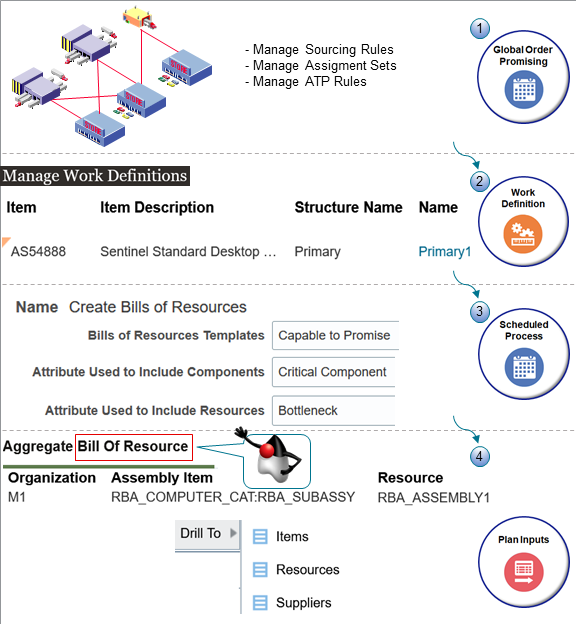Overview of Using Bills of Resources with Promising
A bill of resources includes the critical manufacturing components, subassemblies, and resources that you need to promise an item for an interorganization transfer, manufacturing work order, or purchase order from a supplier. You can use it to help fulfill a sales order when supply isn’t already available in your supply chain.
Use a bill of resources to make your implementation more efficient.
- You can set up a scheduled process that automatically creates a bill of resources from your work definitions in Manufacturing and sourcing rules from Promising.
- You can also manually create one and upload it through file-based data import.
- You specify what items and resources are critical, then the process uses those details to look at only the critical path in your supply chain that you need to deliver the item on time.
Use a bill of resources only with database promising. Don't use it with source promising. For details, see Database Promising and Source Promising.
Here's a summary of your set up.

Note
- You use the Global Order Promising work area to model your supply chain, such as creating a sourcing rule that tells Promising which warehouses, factories and suppliers to source supply for your item, transit times to consider for shipping, and so on.
- You use the Work Definition work area to specify the work that your factory needs to do to create the item, such as the assemblies, subassemblies, and manufacturing components that you need to create the item, what manufacturing components you need for each assembly, what items are critical and which ones aren't, and so on.
- You use the Scheduled Process work area to run the Create Bills of Resources scheduled process. You tell the process to look at only manufacturing components that are critical and resources that are bottlenecks.
-
The scheduled process saves your bill of resources in a simulation set. You use the Aggregate Bill of Resource tab in the Plan Inputs work area to view the bill of resources that the schedule process creates. You can drill into the items, resources, and suppliers that are part of the bill of resources.
Promising uses an input simulation set that you specify to determine how it will promise your sales order when it consumes critical resources and manufacturing components. Promising stores the results of the schedule process in an output simulation set. You can use these output sets to create different bills of resources and store each bill in a different set. You can then compare sets and select the one that works best for you.
BORs & BOMs
A resource is the labor or machines that you use to do an operation that's necessary to create the item. A bill of resources (BOR) is a list of resources. A bill of materials (BOM) is a list of the physical parts that you need to build the item.
A bill of resources can also include data that you would normally have in a bill of materials, such an item or subassembly. You can use a bill of resources to plan capacity so you can prioritize and schedule work in your factory. Here's an example of some of the attributes on a bill of resources.
| Assembly Item | Component Item | Resource | Lead Time Offset in Days | Usage Quantity |
|---|---|---|---|---|
| Deluxe Big Stove | - | Labor for Stove | 3 Days | 8 |
| Deluxe Big Stove | Deluxe Big Stove | - | 3 Days | 2 |
| Oven | - | Labor for Oven | 4 Days | 8 |
| Oven | Safety Glass | - | 4 Days | 4 |
A bill of resources is similar to a bill of materials because they each use a hierarchy where the top level represents the finished item. Here's an example hierarchy of a bill of resources.
Deluxe Big Stove
Burner Top
Burner Knobs
Labor for Stove
Warming Tray
Temperature Control
Pull Handle
Oven
Bluetooth Control
Safety Glass
Labor for Oven
Oven Assembly Machine
Oven Type
Gas
Electric
Window
Note
- This hierarchy represents a configuration model.
- The Deluxe Big Stove is the top-level item.
- The burner top and the burner knobs are manufacturing components that you use when you assemble the stove. Burner Top is a child of the Big Stove, and Burner Knobs is a grandchild of the Big Stove.
- Labor for Stove is a resource. The labor that you need to assemble the stove.
- Labor for Oven is a resource. The the labor that you need to assemble the oven.
- Oven Assembly Machine is a resource. The machine that the Labor for Oven resource uses to assemble the oven.
For details, see Automatically Generate Bills of Resources.